By Graham Gauld
I had a birthday recently. If I had put candles on the cake I would have burned the house down. However one of the advantages of having lived through perhaps the most eventful sixty years of motoring and motor sport is that you have experienced these changes as they have happened and hopefully can put them into some kind of perspective. Another advantage of ageing is that you not only have many memories but many experiences and meetings that will never come around again and, if they have not been written down, will be lost forever. Now your Editor, Peter Vack has offered me the chance to roll out stories that have been triggered by events over the past sixty years and to share some of these moments. Trivial, though they might sometimes appear at first glance, they are nonetheless dropped threads in the fabric of a motoring journalistic life that started out a long time ago. So where do we start?
The BBC and the Machine Gun
It was odd how it came about, really. I was at the Paul Ricard circuit here in the South of France about twelve years ago. I was in the midst of writing my book “Modena Racing Memories” and one of the things that had been nagging me was the reason why Enzo Ferrari put a badge showing a machine gun on the nose of a prototype sedan, called the Ferrarina, launched at his annual press conference in December 1959.
I had not really thought about it before and then I saw an article in Volume XXI/3 of Automobile Quarterly written by Lowell Paddock concerning the Ferrarina – which was later to become the ASA Mille – where he hinted that it was there because of the possible interest by an arms manufacturer to take over the project and build the car.
You see Enzo Ferrari had no intention of building this square little two-door saloon car but it was designed as a package to be sold off and the proceeds to be added to the Ferrari racing budget. However, as we then knew, the Ferrarina prototype did not have the Italian motor industry rushing to beat down the door. Then at some point the machine gun badge disappeared from the grille of the car and a white star was put in its place. Why ?
So here I am at Paul Ricard watching the cars on the old Tour de France rally arrive at the track for a series of races when one of them caught my eye. It was a Mercedes Benz 300SL and on the side a name that meant I had to have a word with the owner, Ugo Gussalli Beretta. He was President of Beretta SpA one of the most famous gunsmiths in the World which , centuries ago, had even supplied guns to Napoleon to fight his wars.
As my old friend Jackie Stewart used Beretta shotguns for the shooting school he ran in Scotland it provided me with a conversational opener and we had an amusing chatabout shot guns and Jackie Stewart before I then slipped in the vital question. “ Did you have any link with Enzo Ferrari and the Ferrarina”? He smiled and said “ No, not me, but my uncle, Piero Beretta who was President of Beretta at the time. I was not long in the business and he came to me one day and said he had received a strange note from Enzo Ferrari asking him to come to Maranello as he had something surprising to show him. He said he was going down and would I go with him”.
Ugo then went on to tell me that his uncle had always wanted to build a small car. Back in 1948 he, with his friends Count Luigi Castelbarco, a well known racing driver of the day, and Guiseppe Benelli, the boss of the Benelli motorcycle company decided they would build three prototypes of a small capacity car and perhaps put it on the market. It was to be called the BBC for Beretta, Benelli and Castelbarco. The three prototypes were built, all with their own 750cc air-cooled V-twin engine with a steel block and aluminium heads. Remember, this was 1948 and Italy was still in a terrible state after the ravages of war. It became clear that they would not be able to put the car on the market due to the short supply of steel which was being swallowed up in the rebuilding of Italy. The three partners abandoned the project and each of them kept a prototype.
Now, here was Enzo Ferrari, who obviously knew of Piero Beretta’s fascination with building a small car, inviting him to Maranello. When they arrived Ugo explained that Enzo Ferrari, ever the showman, whipped a cover off the Ferrarina and let them see the prototype. “ I turned to my uncle and said that’s a model of our new machine gun on the grille”. After a conversation Piero Beretta said that he really was no longer interested in building a car and so walked away from the deal. Clearly miffed, Enzo Ferrari had the machine gun badge taken off the grille and replaced with a white star. A couple of years later he sold the project to the De Nora brothers who punched the 850cc engine out to 1000ccs, clothed it in a neat little coupe body and renamed it the ASA Mille. Pretty though it was it was far too expensive to be a commercial success and the company eventually folded.
What also made the story interesting to me was that on my visit to Maranello in 1960 Mr Ferrari showed me a GT version of the 850cc engine on a stand in the racing department and it was complete with the black crackle enamel on the heads and 854 ( 850cc ,4 cylinder stamped on it).
I remember later telling the Beretta story to Mauro Forghieri who explained that the engine was in fact based on a Fiat 1100cc block to which a twin cam head had been designed and built at Ferrari. Gianni Agnelli at Fiat had approved the changes to his engine and two engines were built each with a different configuration. One was almost square, 65mm x 64mm and the other 67mm x 69mm. The first engine, the 850cc was in fact more powerful than the larger 973cc engine and was the one in the photograph.
Mauro Forghieri then went on to explain that when he was thrown in at the deep end at Ferrari, and made chief engineer in the racing department when Carlo Chiti was fired, he went to Mr. Ferrari and explained that as he was meant to travel to the race meetings he had a problem as he didn’t have a car. “ So my first company car at Ferrari was the Ferrarina prototype with the white star on the front of it”. In the many years since then I have never been able to find out what actually happened to that prototype but fear it probably went the way of many cars at Ferrari; into the scrap yard, torched and then sold off to a scrap merchant.
To me the ASA story was tragic, really, because it was truly a pretty little car but thankfully this has been recognised and they are now collectable provided you can find one. The late Fabrizio Violatti has one in his Maranello Rosso collection in San Marino and my last sighting of one came about four years ago in strange circumstances. Luigi Chinetti and I took the train from Retromobile in Paris to Modena as he wanted to go round some of the small establishments in the Modena area where he had various cars being fettled. One afternoon we called in to see one of his favourite engine men who worked out of a small unit on an industrial estate outside Modena. Whilst Luigi talked about an engine rebuild I wandered around looking at the variety of odd cars that were lying about and there, to my surprise, was not only an ASA Mille but an ASA Mille that Luigi’s father had imported into the USA and was fitted out with NART stickers. What a coincidence, and as you can see throughout this convoluted tale, coincidences are my stock in trade. Somehow I seem to gather them around me like a security blanket and I never tire of such chance meetings and their outcome.
* * * *
Cabrio Dauphine
Living in the South of France means that you get dragged into the motor sport milieu at grass roots level as well as the major events. I must admit I don’t go to many of the big events any more because there are too many people there and I prefer to go to smaller events. Let me give you an idea of the kind of thing. A local owner of a vineyard near here is Jean-Louis Vial who produces a very drinkable Cote de Provence red wine but is also a motor sport enthusiast. His father organised the Grand Prix of Brignoles, his local town, back in 1931 and this is a subject I will come back to in a later column.
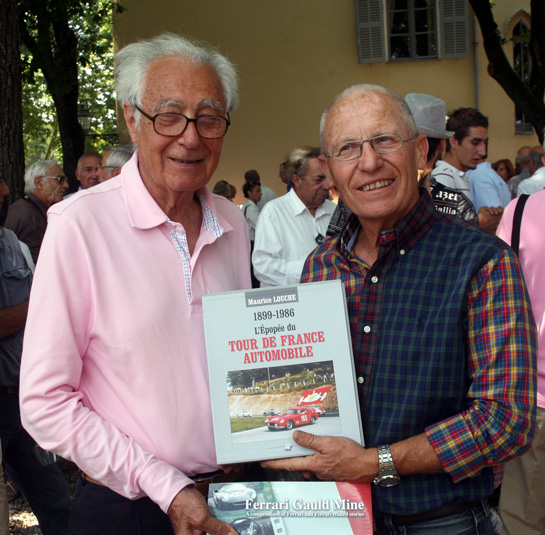
One of the visitors to the Viale vineyard was Ferrari driver Jean Guichet, left, with French automotive author Maurice Louche.
However, all the vineyards in the area choose one weekend in the year for what is called “Vin et Art” so most of them invite along an artist to show his work and perhaps to sell a canvas or two. It attracts visitors, they have a wine tasting and everyone is happy. Jean-Louis, however, gets all his motor sport pals together for his “do” and to keep in fashion he invites artist, sculptor and racer Francois Chevalier to show his work and author Maurice Louche to bring along copies of his books on the Tour De France, Ferrari etc. It is a great day out and this year Jean Guichet, former Le Mans winner and Ferrari driver, turned up to buy a copy of Maurice’s book on the Tour de France rally as Guichet was a winner of that too. However I spied an interesting little powder blue car an enthusiast brought along and it was the first of its type I had ever seen.
The car was a Brissonneau. Beautifully built, it was a cabriolet built on the subframe of the Renault Dauphine sedan. Yves Brissonneau was a member of a family that specialised in building railway engines since the middle of the 19th century. Yves was 23, wanted to do something different and was not all that keen on railway engines so he and French racing driver Louis Rosier decided to build this small cabriolet based on the Dauphine. Unfortunately Rosier was killed in a racing accident at Montlhery just before the car was first shown and so it was young Yves who launched the car in 1957. Around 200 of them were built but this stopped when Brissonneau were given the contract to build the Renault Floride and later the Caravelle road cars. As you can see it was a pretty little car and pity it didn’t catch on.
Portions of this article appeared in Graham Gauld’s book Modena Racing Memories
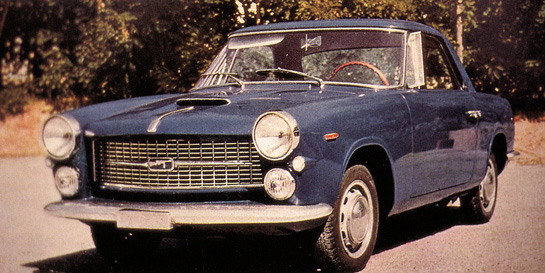
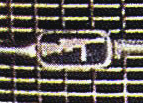
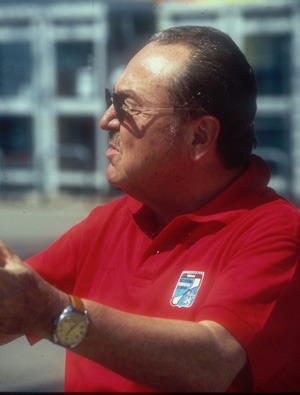
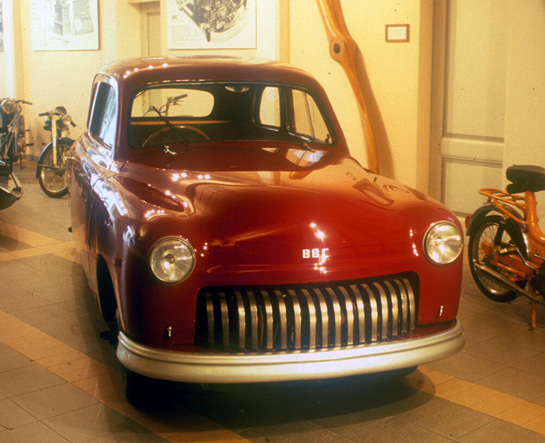
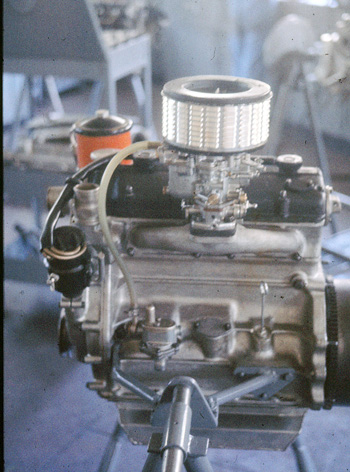
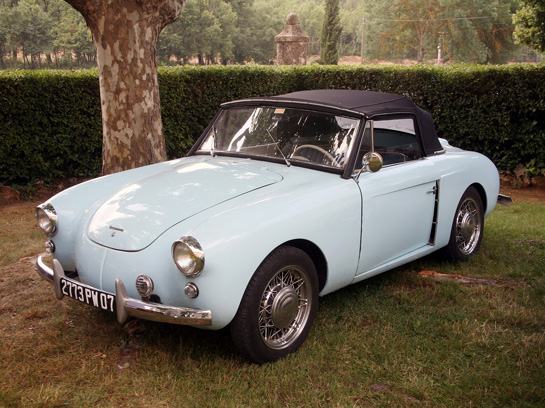
I can’t help but wonder if Aurelio Lampredi based his Fiat 124 twin cam engine’s head design on the Ferrari 854? Obviously the timing belt drive was new but maybe the 124’s semi-hemispherical combustion chambers were carryovers. Great story and thanks for setting the lore right about the machine gun badge on the prototype!
I’m glad to see Graham Gauld joining Veloce Today as I consider him one of the best raconteurs around today. His tales are personal and factual. One of the best motor racing books on my shelves is his “Modena Racing Memories.” If you don’t have this book on your shelves, then I don’t think you can call yourself a motor racing aficionado! I look forward to many interesting tales from the very interesting Mr. Gauld.
I owned an ASA 1000, and the engine was definitely not a Fiat derivation. It was a single overhead cam 4 cylinder comprising four cylinders the size of the cylinders in the V12 3 liter Ferraris. The body was by Bertone from a design by Giugaro. It was very pretty. An article about the car was published in “Sports Car Quarterly”. I also had an Alpine Renault A106 which had some similarity to the Renault shown in the article. It was built on a 4CV chassis which was similar but shorter than the Dauphine. I have photos. Don
boyoboy are you gonna get tons of great and rare stories from GG!
Graham,
It’s great to see you writing for Veloce Today.
Your friends in Adelaide are looking forward to seeing more of your great stories.
You can never learn enough about Etceterinis and what a great author, I’m ordering “Modena racing memories” pronto.
I bought my copy of Modena Racing Memories when it was first published and have cherished it since. That GG drove to Italy and back in a Heinkel bubble car was very impressive, but I loved the pictures from the Modanese workshops and at the local racetrack. It makes me wish I could travel back in time and be there myself.
Simply fabulous. Great to be able to read some unaffected tales of great times. This is what it is all really about and I look forward to much more.
Cheers
Adrian
Happy Birthday Graham and many, many more!
We’d love to see you back here for the Classic Targa Adelaide next spring to catch up where we left off. My vote for the Turn of Phrase Award goes to your tale of Roy Clarkson, the “wild Scots dentist” and his Morgan based “faux -Ferrari” which “had a bad habit of turning into corners before the chassis did”.
Please could you let us know when More Modena Racing Memories and Gauld Mine Vol 2, 3 and 4 will be ready?
Vince Johnson
The ASA 1000 GT is a really pretty small car, very stylish! I’ve been lucky enough to see both a coupe AND a very rare spider here in San Diego. It may be the ultimate “microcar…” I must be old school, because I fail to see any reason to own a Smart car, with all the pretty classic small car choices out there.
Looking at the headlight arrangement of the Ferrarina it suddenly strikes me that it is virtually similar to that of Enzo Ferrari’s coachbuilt Mini Cooper, a mystery to Mini researchers like myself. Could they have been built by one and the same coachbuilder?
Dear readers,
Our friend, ASA owner and VT contributor from Australia, Ean McDowell, has pointed out that the production ASAs do not have a Fiat 11oo block. Mr. Gauld’s response was that the article was referring only to the Ferrari engine (the 854). We should have made it clearer that when the ASA project was developed they chose to go to the bigger engine which they developed themselves. Many thanks for the clarifications!
[Ed.]
Graham
Another brilliant batch of stories. I acn’t wait to see more of them on this magnificent website.
Fangio
Robert, a note from Graham…
Robert
As a noted historian in South Africa and one of the founders of Classic Car Africa I appreciate your comments but why call yourself Fangio ? Thanks again
Graham Gauld
17-09-2014
Suggestion: have you thought of going to all the car auction houses that you cover so brilliantly and ask for a percentage of the sales — like 0 .00015% so you could cover your costs and not need subscripti0n donations? After all, you do a lot of positive work for them.
You might be surprised by the positive results. Allan